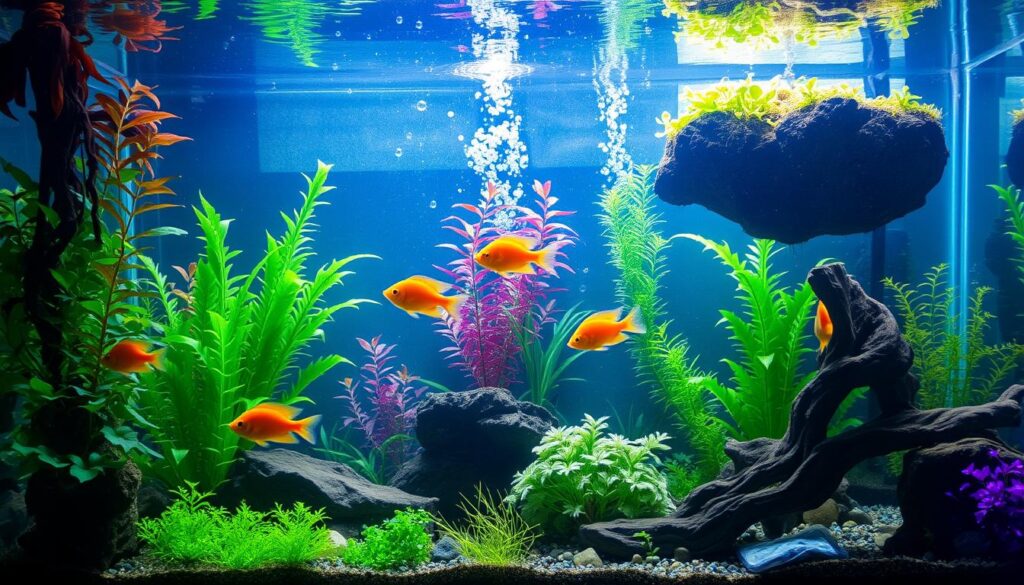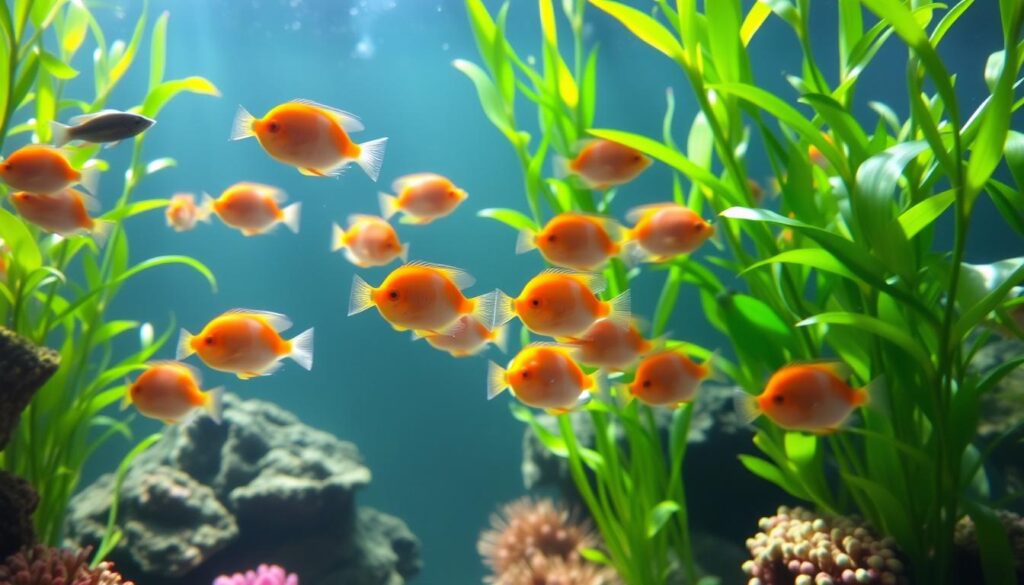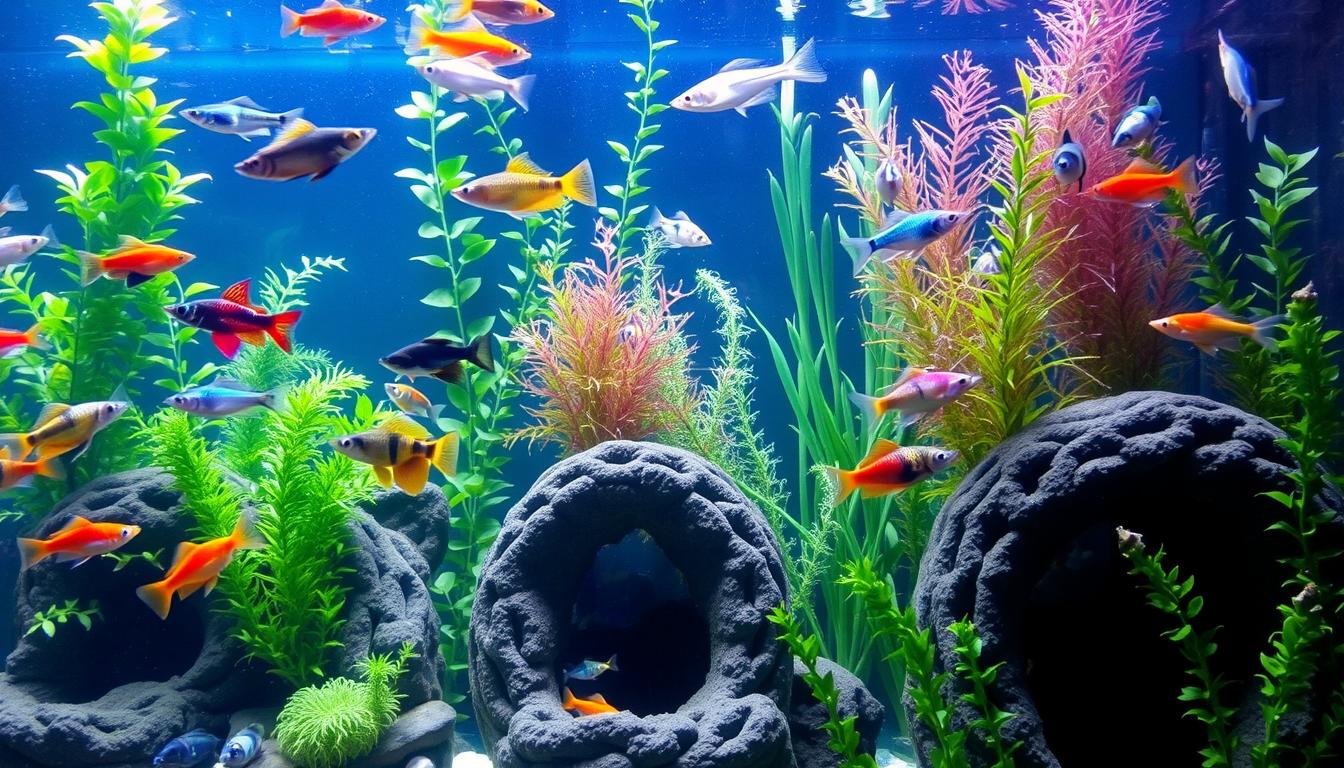For many aquarium fans, breeding fish is both fascinating and rewarding. It needs a deep understanding of tropical fish breeding and good fish breeding tips. This guide is for both newbies and seasoned aquarists, offering the knowledge to breed aquarium fish successfully.
This guide covers everything from fish reproduction basics to advanced breeding techniques. It provides valuable insights and tips. By following this guide, you’ll become a skilled tropical fish breeder. You’ll learn the best practices and expert tips for breeding aquarium fish.
Key Takeaways
- Understand the basics of fish reproduction and tropical fish breeding
- Learn effective fish breeding tips for successful breeding
- Discover the best practices for breeding aquarium fish
- Implement expert techniques for raising healthy fish
- Explore the world of breeding aquarium fish and its many rewards
- Apply knowledge of fish breeding to create a thriving aquarium
Understanding the Basics of Breeding Aquarium Fish
To breed freshwater fish, knowing the basics of fish reproduction is key. Breeding techniques for aquarium fish require understanding sexual and asexual reproduction.
When breeding aquarium fish, several factors are important. These include sexual vs. asexual reproduction, identifying male and female fish, and recognizing breeding age and maturity. Knowing these basics helps prepare your fish for breeding and boosts the chances of a successful spawn.
Sexual vs. Asexual Reproduction in Fish
Sexual reproduction in fish involves male and female gametes coming together. This is common in aquarium fish. Asexual reproduction, however, produces offspring without male gametes.
Identifying Male and Female Fish
It’s crucial to identify male and female fish for successful breeding. In many species, males and females differ in size, color, or fin shape. For instance, male guppies are smaller and more colorful than females.
Breeding Age and Maturity Signs
Knowing when fish are ready to breed is vital. Most species are ready between 6-12 months, depending on diet and water quality. Signs of maturity include color changes, fin shape, and behavior.
Understanding fish reproduction and breeding techniques for aquarium fish sets you up for success. With the right knowledge and equipment, you can create a thriving breeding program. This way, you can enjoy raising healthy, vibrant fish.
Essential Equipment for Fish Breeding
For spawning aquarium fish, the right gear is key. To make money from breeding fish for profit, you need a few important items. These include a special breeding tank, a good filter, and a heater for the right water temperature.
A top-notch filter keeps the water clean and healthy. This is crucial for your fish’s health. You’ll also need a reliable heater to keep the water at the right temperature. This helps your fish want to breed. Don’t forget a hydrometer and pH test kit to check the water’s quality.
For breeding fish for profit, you’ll also need a tank for fry, fish nets, and an egg incubator. Knowing how to keep the water quality right is also important. With the right equipment and knowledge, you can succeed in breeding fish for profit.
Here’s what you’ll need to start:
- A dedicated breeding tank
- A reliable filter system
- A heater to maintain optimal water temperatures
- A hydrometer and pH test kit
- A separate tank for raising fry
- A variety of fish nets
- A fish egg incubator
Creating the Perfect Breeding Environment
Successful fish breeding needs a well-planned environment. This environment must meet the fish’s specific needs. Raising fry aquarium fish can be tough, but with the right setup, it’s rewarding. To create the perfect breeding environment, consider water quality, temperature, lighting, and breeding tank setup.
Water parameters must be right for the fish species. This means keeping pH, ammonia, nitrite, and nitrate levels optimal. Regular water changes are key to prevent toxins and keep water quality high. Also, a stable temperature between 76-82°F (24-28°C) is best for most tropical fish.

Lighting needs vary among fish. Some, like bettas and gouramis, prefer low lighting. Others, like tetras and cichlids, do well in brightly lit areas. A breeding tank should look like the fish’s natural habitat, with plants, hiding spots, and open swimming areas. This setup boosts the chances of successful breeding and raising healthy fry.
- Monitor water parameters regularly
- Maintain a stable temperature
- Provide suitable lighting
- Create a natural environment with plants and hiding places
By following these tips, aquarists can create a great breeding environment. This environment supports the health and well-being of their fish. It leads to successful breeding and raising healthy fry aquarium fish.
Selecting Healthy Parent Fish
When you’re into breeding aquarium fish, picking healthy parents is key. Healthy parents mean healthier babies, which is vital for any fish breeding effort. Look for fish that are in top shape, active, and have a good mix of genes.
Here are some important traits to spot in healthy parent fish:
- Active swimming and responsive behavior
- Good appetite and digestion
- No visible signs of disease or injury
- Genetic diversity to ensure a healthy and robust offspring
By following these fish breeding tips, you can boost your chances of successful breeding aquarium fish. Always put your fish’s health first. If you’re not sure about anything, get expert advice.
Different Methods of Tropical Fish Breeding
Tropical fish breeding uses many techniques, each with its own needs. These methods include egg scattering, bubble nest building, and mouth brooding. Knowing these is key for breeding success.
Choosing the right breeding method is crucial. Some fish, like tetras and guppies, breed easily. Others, like bettas and labyrinth fish, need special care.
- Egg scattering: Eggs are released into the water, where they hatch into larvae.
- Bubble nest building: The male fish makes a bubble nest for the female to lay eggs.
- Mouth brooding: The fish takes the eggs into their mouth for protection until they hatch.
By picking the right breeding method for your fish, you can raise healthy fish. This brings joy and rewards to your aquarium.
Conditioning Parent Fish for Breeding
Proper conditioning of parent fish is key for successful breeding. This means giving them the best water quality, food, and environment. A balanced diet is crucial for spawning aquarium fish.
To get your fish ready for breeding, focus on nutrition and water quality. A diet full of protein and nutrients boosts their reproductive system. Also, keeping water parameters like pH and temperature right reduces stress and encourages breeding.
- Provide a varied and nutrient-rich diet that includes live or frozen foods
- Maintain optimal water parameters, including pH, temperature, and hardness
- Ensure adequate water circulation and oxygenation
By following these steps, you can prepare your fish for breeding. This is true for both freshwater fish and aquarium fish. Good conditioning boosts spawning chances and keeps the fish and their babies healthy.
Spawning Triggers and Breeding Behavior
Understanding what makes fish spawn is key to breeding them for profit. It’s important to know the signs of spawning and create the right environment. This helps to mimic the natural conditions that trigger spawning in the wild.
In nature, fish spawn due to changes in their environment, like water temperature or pH. To mimic these conditions in a tank, aquarists can use artificial stimulation methods. This includes changing water parameters or adding specific plants or decorations.
Natural Triggers
- Changes in water temperature
- Changes in water pH
- Presence of certain plants or structures
Artificial Stimulation Methods
Aquarists can use artificial methods to encourage spawning. They can adjust water parameters or add plants that look like the fish’s natural habitat. These actions help increase the chances of successful spawning and improve fish health.
Recognition of Spawning Signs
It’s crucial to recognize the signs of spawning. Aquarists should watch for changes in fish behavior, like color changes or increased aggression. By spotting these signs, aquarists can create the best conditions for spawning and boost their chances of breeding fish for profit.
Caring for Fish Eggs
Caring for fish eggs is key in breeding aquarium fish. To get successful hatching and healthy fry, you need to keep water quality, temperature, and feeding right. For instance, a proper aquarium setup is crucial for fish eggs to grow well.
Some important things to consider for fish egg care are:
- Keeping water temperatures steady between 72-82°F (22-28°C)
- Checking water quality and changing it regularly
- Feeding the fry enough and the right food
By following these tips and using the right methods for raising fry aquarium fish
Remember, caring for fish eggs needs careful attention and a commitment to the best conditions. With the right care, your fish eggs can hatch well and your fry will grow strong and healthy.
Raising Newly Hatched Fry
When breeding aquarium fish, the early stages are key. Tropical fish breeding needs careful attention to the fry’s nutrition and environment. The right conditions help them survive and grow well.
Feeding the fry is crucial. First foods for fry must be nutritious and easy to digest. Good options include:
- Infusoria
- Brine shrimp
- Commercial fry food
These foods give the fry the nutrients they need to grow.
As fry grow, their needs change. It’s important to watch their development and adjust their diet and environment. Regular water changes, proper filtration, and a balanced diet help prevent diseases.

By following these guidelines, you can help your fry grow into healthy fish. Whether you’re experienced or new to breeding, understanding fry needs is key to success.
Common Challenges in Fish Breeding
Many people face challenges when breeding freshwater fish. Disease is a big worry, as it can spread fast and harm the fish. Water quality issues also play a big role, as bad water can stress fish and make them sick.
Some common challenges in fish breeding include:
- Disease outbreaks
- Water quality issues
- Genetic problems
- Poor breeding techniques
To beat these challenges, breeders need to know how. Keeping water clean, creating a healthy space, and using the right breeding methods are key. This helps avoid disease and genetic issues.
With the right knowledge, breeders can succeed. Keeping up with new research and techniques helps improve their chances. This way, they can breed healthier fish.
Breeding Specific Popular Species
Different fish species have their own needs and challenges when it comes to breeding. To breed fish for profit, knowing what each species needs is key. Guppies and livebearers are great for beginners because they’re easy to breed.
Bettas and labyrinth fish need more care. Tetras and egg scatterers do well in groups, making them perfect for community tanks. Understanding each species’ breeding needs helps you succeed in breeding fish.
Guppies and Livebearers
- Easy to breed and care for
- Produce live young, eliminating the need for egg incubation
- Can be bred in small groups or pairs
Bettas and Labyrinth Fish
- Require specialized care and attention
- Need separate breeding tanks with specific water parameters
- Can be challenging to breed, but rewarding for experienced aquarists
Researching each species’ breeding needs boosts your chances of success. Whether you’re new or experienced, breeding popular species can be both rewarding and profitable.
Profitable Aspects of Breeding Aquarium Fish
For those into breeding aquarium fish, knowing the market and money side is key. You need to think about the costs for gear, food, and upkeep. Check out the Aquarium Coop blog for tips on making money from breeding aquarium fish.
Understanding the market is vital for successful fish breeding. You should look into what species are in demand and who else is breeding them. Also, don’t forget to think about the costs of equipment, food, and upkeep. This will help you make money.

Market Analysis and Cost Considerations
When you analyze the market, find out which fish are most profitable. Look at the costs of breeding these fish. This will help you decide what to breed.
- Initial investment in equipment and supplies
- Ongoing costs of food and maintenance
- Potential revenue from selling fish to local pet stores or online
By thinking about these points and doing good market research, you can do well in breeding aquarium fish. You’ll have a chance to make a profit.
Record Keeping and Breeding Logs
Keeping accurate records and breeding logs is key when breeding aquarium fish. It helps track your breeding program’s progress and makes informed decisions easier. By following fish breeding tips and keeping good breeding logs, you can boost your breeding success.
A good breeding log should have details like:
- Parent fish details, including species, age, and health status
- Breeding dates and methods
- Egg or fry counts
- Water parameters and quality
By looking at this data, you can spot patterns and trends. This helps you tweak your breeding program for better results. For instance, you might find that some breeding aquarium fish species prefer certain water temperatures or qualities. Then, you can adjust your breeding conditions to meet their needs.
Keeping good records and breeding logs is vital for your fish breeding success. By following these fish breeding tips and keeping accurate records, you can fine-tune your breeding methods. This way, you can achieve better results and become a top breeder of breeding aquarium fish.
Keys to Long-term Breeding Success
To succeed in breeding aquarium fish for the long haul, you need to know a lot, get your hands dirty, and stay committed. The keys to long-term breeding success are picking healthy parents, creating the best breeding space, and keeping detailed records.
Start by choosing top-notch, diverse tropical fish for your breeding program. This step is key to getting healthy, colorful fry. Also, watch your water and temperature closely to make the perfect breeding techniques for aquarium fish.
Keeping a detailed log of your breeding journey is crucial. It helps you track everything from spawning to fry growth. This info lets you tweak your methods and keep your breeding program thriving.
FAQ
What are the differences between sexual and asexual reproduction in fish?
Sexual reproduction in fish means male and female gametes combine to make offspring. Asexual reproduction, on the other hand, involves a single parent fish dividing to create genetically identical offspring.
How can I identify male and female fish?
You can tell male and female fish by their size, color, and fin shape. Also, look for courtship displays and aggression to guess their sex.
What are the signs of breeding age and maturity in fish?
Signs of breeding age include bigger size, brighter colors, and secondary sexual characteristics. Increased activity and courtship displays also show they’re ready to breed.
What essential equipment do I need for fish breeding?
You’ll need a dedicated breeding tank, good filtration, heaters, and lighting. Water quality testing kits and spawning mops or substrate are also key for success.
How do I create the perfect breeding environment for my fish?
For a great breeding environment, focus on water parameters, temperature, lighting, and tank setup. Stable water quality, the right temperature, and proper tank setup are crucial.
How do I select healthy parent fish for breeding?
Choose parent fish with vibrant colors, active behavior, and no signs of disease. Genetic diversity is also important to avoid inbreeding issues.
What are the different methods of tropical fish breeding?
There are several breeding methods, like egg scattering, bubble nest building, and mouth brooding. Each method has its own needs and challenges, depending on the fish species.
How do I condition parent fish for breeding?
To condition parent fish, feed them well, keep the water quality high, and create the right environment. This ensures they’re healthy and ready to spawn.
What are the natural triggers and artificial stimulation methods for fish spawning?
Natural triggers include changes in water parameters, temperature, and photoperiod. Artificial methods, like water changes or hormonal treatments, can also induce spawning.
How do I care for fish eggs once they have been laid?
To care for fish eggs, keep the water quality, temperature, and prevent infections. Regular water changes and monitoring the eggs are essential.
What are the first foods for newly hatched fry, and how do I ensure their healthy growth?
New fry need specialized foods like infusoria or micro-worms. Providing the right nutrition, maintaining water quality, and preventing diseases are key for their growth.
What are some common challenges in fish breeding, and how can I overcome them?
Challenges include disease, water quality issues, and genetic problems. Proper quarantine, stable water, and careful breeding stock selection can help overcome these.
How do I breed specific popular fish species, such as guppies, bettas, and tetras?
Each species has unique breeding needs and behaviors. Understanding these is crucial for successful breeding and raising their offspring.
How can I make my fish breeding venture profitable?
To profit from fish breeding, research market demand, consider production costs, and find effective sales channels. Good record-keeping and planning can also help your business succeed.
Why is it important to keep accurate records and breeding logs?
Keeping detailed records helps track your breeding program’s progress. It identifies successful pairs and guides better decisions for future success.
What are the keys to achieving long-term breeding success?
Long-term success in breeding requires healthy, diverse parent fish, optimal conditions, and effective record-keeping. Continuous learning and adapting your techniques are also important.

